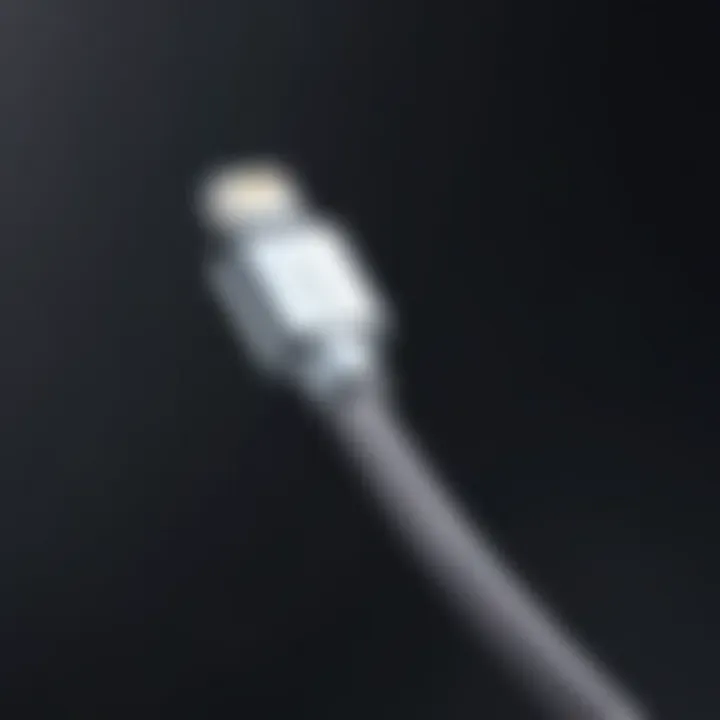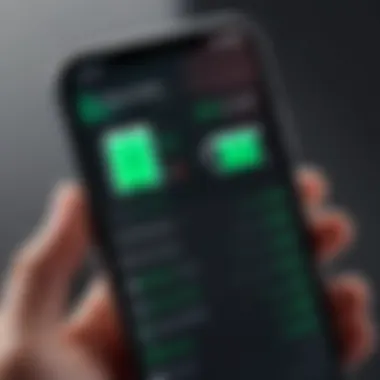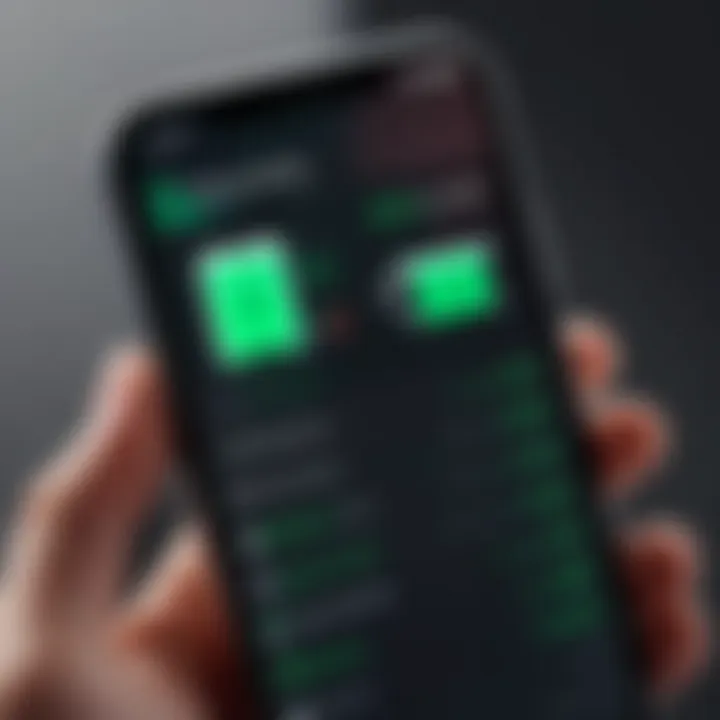Resolving iPhone Charging Issues: A Comprehensive Guide


Intro
Charging issues with an iPhone can cause a world of headaches. It's not just about running out of battery, but the frustration of trying to pinpoint what exactly is going wrong. Are you dealing with a worn-out cable? Is there something gunking up the charging port? Perhaps a software hiccup or a glitchy setting is at play? This guide aims to shine a light on all those pesky problems.
It’s vital to understand the underlying causes of charging failures. Whether you're a tech-savvy individual or someone who relies on devices for everyday tasks, knowing how to troubleshoot your iPhone effectively is key to maintaining its longevity and performance. By diving into the nitty-gritty of hardware, software, and accessory-related issues, you'll find ways to methodically diagnose and resolve any obstacles standing between your iPhone and a full battery.
In this comprehensive guide, we’ll cover everything from identifying common issues to ensuring compatibility with your charging accessories. Buckle up; it’s time to power up your understanding of iPhone charging problems.
Preface to iPhone Charging Problems
The moment an iPhone's battery dips into the red, a sudden wave of anxiety washes over any user—especially in today’s fast-paced world where connectivity is king. The importance of understanding iPhone charging problems cannot be understated. It’s not merely about allowing a device to function; it’s about keeping our digital lives intact. From missed calls to stressful notifications left unchecked, charging failures can lead to a cascade of frustrations.
Delving into this subject equips users with both insight and tools to tackle charging issues effectively. A little knowledge goes a long way, especially when it comes to effectively identifying whether a problem lies within the device itself or if it’s something external, like a charger gone rogue. Recognizing that not all resolutions require professional services can save valuable time and ensure a smoother daily experience with an iPhone.
The Importance of Battery Functionality
At the heart of every iPhone is its battery, functioning similarly to a fuel tank for a car. If the battery isn’t working properly, even the most advanced features will be useless. It’s essential to understand how the battery operates as this knowledge aids in recognizing potential underlying issues.
A healthy battery doesn’t just keep your device powered; it underpins performance and longevity. This means knowing how to monitor battery health can significantly affect how users interact with their devices. For instance, iPhone batteries typically start showing signs of wear after a few hundred charge cycles. So, being proactive about battery management—like making sure the battery calibration is correct—might just prolong its usable lifetime.
Common Symptoms of Charging Failures
When an iPhone refuses to charge, there are telltale signs that can clue users in on what's gone awry. Familiarizing oneself with these symptoms is crucial as they can indicate more than just a dead battery. Here are some common indicators:
- Unresponsive Device: If the iPhone doesn’t respond when plugged in, it could be a sign that the phone is unable to recognize the power supply.
- Charging Icon Issues: Sometimes the charging indicator may flash on and off or not appear at all, hinting at either software or hardware issues.
- Heat Generation: If the device feels unusually warm while charging, that can signal a malfunction either in the charger or the iPhone itself.
Awareness of these symptoms can aid users in taking informed steps toward troubleshooting, ensuring that their devices stay functional and reliable.
"The goal isn't just to fix the problem when it arises; it's to understand it fully so you can avoid future headaches."
By grasping these fundamentals, users set the stage for a more comprehensive understanding of their devices in subsequent sections.
Understanding the Charging Mechanism
A solid grasp of how iPhone charging operates lays a fundamental basis for troubleshooting any issues related to charging failures. Understanding the intricacies of this mechanism helps users pinpoint problems related to hardware or software, allowing for efficient resolutions. Knowledge of this system not only equips one with the skills to address current problems but alsoprepares for future concerns.
How iPhone Charging Works
When you plug your iPhone into a power source, a series of steps unfolds that converts electrical energy from the charger to the battery. Initially, the charger connects to the phone through a charging cable. Depending on the type of adaptor or charging method used—like Apple’s fast charging or standard USB power—a differing amount of current flows into the device.
The iPhone's charging process begins as electrical energy from the socket or power bank travels through the designated cable, hitting that precious charging port. This energy is then directed to the battery through the Battery Management System (BMS). It’s worth noting that the routine features an intelligent regulation of voltage and current, adjusting automatically based on battery needs and the charging environment. This mechanism prevents overheating and prolongs battery life, a fundamental consideration for iPhone users.
Role of the Battery and Charging
The battery is the heart of any mobile device, including Apple's flagship product. Within the iPhone, a lithium-ion battery is generally employed, valued for its lightweight and capacity to hold significant energy. This battery plays a pivotal role in holding charge and ensuring that the device operates throughout the day.
However, the magic doesn’t stop there; the Charging Integrated Circuit (IC) works diligently alongside the battery. This IC is a tiny but critical component that governs the charging process by efficiently regulating the power flow. Its function can be likened to a maestro orchestrating the charging symphony, ensuring that every element synchronizes perfectly. The IC monitors the battery's state of charge, temperature, and overall health, causing the charging speed to fluctuate appropriately.
"Understanding the charging mechanism not only aids in troubleshooting but also enhances the longevity of a device."
By recognizing these two key components—the battery and the Charging IC—users can better interpret charging issues when they arise. Whether the battery is degrading or the IC is malfunctioning, knowledge around these mechanisms provides a clearer framework for diagnosing and resolving charging troubles.
Maintaining awareness about how iPhones charge opens a broader dialogue not only on hardware but also on how to care for these intricate devices. Small issues can result in larger headaches if they are left unchecked. Knowledge is power, particularly in the gadget domain, and understanding charging mechanics makes you that much more adept at handling any bumps along the road.
Potential Hardware Issues


When it comes to resolving iPhone charging problems, hardware issues often sit at the core of most dilemmas. Understanding and identifying these potential hardware problems can mean the difference between a simple fix and a frustrating trip to the repair shop. In this section, we will explore crucial hardware components that can impact charging capabilities, offering insights on what to look for and how to address these issues effectively.
Examining the Charging Port
The charging port is the gateway for power to flow into your iPhone, making it a prime suspect when troubleshooting charging issues. Noticing anything unusual? You're probably not alone. A thorough examination of the charging port can reveal a lot about the state of your device's ability to charge.
Signs of Damage or Obstruction
The first signs of trouble often manifest as visible damage or obstructions within the charging port. If you notice debris, dust, or lint accumulated, that can block the connection and prevent charging. Damage might be subtle — think bent pins or cracks that can be overlooked. Regular checks can make a big difference here.
- Key Characteristic: Easily identifiable through visual inspection, making it the first go-to for troubleshooting when issues arise.
- Advantage: Quick to assess, and straightforward to remedy in many cases, this makes troubleshooting more efficient.
- Disadvantage: Sometimes, the damage may be internal, requiring more advanced diagnostic tools to uncover.
Cleaning the Charging Port Safely
Once you've identified potential obstructions, the next step is a careful cleaning. Using compressed air or a soft brush can clear out the accumulated dirt, but caution is essential. Damaging the delicate components inside the port could create more problems than it solves.
- Key Characteristic: A straightforward and safe practice that ensures better connectivity for charging.
- Advantage: Regular cleaning can prolong the lifespan of the charging port and improve performance.
- Disadvantage: Improper cleaning methods can damage the port, resulting in the need for a costly repair.
Assessing the Charger and Cable
Next on the list is the charger and cable, as these accessories are often the lowest-hanging fruit when seeking charging solutions. Their condition, compatibility, and authenticity can have a significant impact on performance.
Identifying Faulty Cables
Faulty cables are a common and often overlooked reason for charging failures. Frayed wires, broken connectors, or insulation damage can lead to inconsistent charging performance. Conducting a visual inspection can reveal glaring issues, but sometimes the damage is hidden within the cable itself.
- Key Characteristic: Unreliable charging caused by wear and tear.
- Advantage: Identifying a faulty cable can prompt you to seek a replacement, often resolving the issue without further hassle.
- Disadvantage: A replacement might be necessary, and the ongoing purchasing of chargers can add up.
Using Authentic Accessories
The use of authentic accessories, such as Apple's Lightning cable, goes a long way in ensuring smooth operation. Non-genuine products can, despite their lower costs, offer subpar performance and even exacerbate charging woes.
- Key Characteristic: Designed specifically for iPhones, ensuring compatibility and reliability.
- Advantage: Using legit items typically provides peace of mind and eliminates concerns over safety hazards like overheating.
- Disadvantage: Higher costs compared to non-genuine products could deter some users.
Battery Health Considerations
Even if all external components seem intact, battery health plays a crucial role. A battery that is worn or degraded will struggle to hold a charge, leading to frustrating symptoms.
Monitoring Battery Performance
Being mindful of your battery's health is important, especially as iPhones age. Poor performance could be reflective of a battery that has exceeded its lifecycle. Tools and inbuilt diagnostics in iOS can aid significantly in monitoring battery metrics.
- Key Characteristic: Offers insight into how well the battery is functioning.
- Advantage: Knowing the battery's status allows for proactive measures, preventing unforeseen disruption in usage.
- Disadvantage: Delays in addressing battery depletion can lead to more complicated problems down the line, like complete failures.
Recognizing When to Replace the Battery
Eventually, all batteries show their age. Recognizing signs that indicate a need for replacement can save a lot of disappointment. Indicators like rapid battery depletion or a device that only works while plugged in signal that it might be time for a change.
- Key Characteristic: Enables users to plan for maintenance.
- Advantage: Prevents unexpected shutdowns, helping keep the device dependable.
- Disadvantage: Replacement may incur costs and some downtime while the work is done.
Understanding these potential hardware issues not only prepares you for quick solutions but also empowers you to maintain your iPhone effectively. Keeping an eye on these elements will ensure that you can address charging problems efficiently.
Software-Related Factors
Addressing software-related factors is crucial when tackling iPhone charging issues. Many users overlook the impact that software can have on their devices, often attributing problems solely to hardware faults. However, software glitches and updates can disrupt the charging process just as severely as a damaged cable or port. Understanding this relationship can save users considerable time and effort when seeking solutions.
Identifying Software Glitches


Common Software Causes
Software glitches often serve as the invisible hand disrupting an otherwise well-functioning device. These issues could stem from a variety of sources, such as app malfunctions, memory overload, or even system bugs. An innate quality of software systems is their complexity. This can mean that a minor glitch in one app causes wider ramifications for system performance, including charging ability.
For instance, a rogue app that keeps running in the background can hog resources, causing the phone to respond sluggishly or not at all to the charging process. This reality makes understanding common software causes vital. Recognizing these issues enables users to tackle them effectively. A benefit of identifying these glitches early on is that it often leads to simple fixes that don't require professional intervention—saving both time and money.
Unsurprisingly, many users might encounter these glitches at some point. The unique feature of this aspect lies in its often fleeting nature; a minor tweak or restart may resolve the entire situation just like that. However, continuous problems could signal deeper issues in the operating system, requiring a more thorough examination.
Diagnostic Tools Available
Utilizing diagnostic tools can greatly aid in identifying software-related issues. These tools help analyze the device's performance, highlight inconsistencies, and detect underlying problems. A key characteristic of these tools is their user-friendly interfaces, which allow tech-savvy users or even those who are not so tech-literate to navigate with ease.
For example, apps like Apple’s built-in diagnostics or third-party options such as Tenorshare ReiBoot can pinpoint software issues affecting charging. The unique feature of these tools is their ability to generate reports based on the device's performance. This not only helps in understanding the current state of the iPhone but also in tracing back the origins of the issue. However, one must keep in mind that relying solely on these diagnostic tools could lead to other oversights. They are beneficial but should complement other troubleshooting methods rather than stand as the only measure.
The Impact of Updates
Ensuring iOS is Up to Date
Keeping the iOS updated is a fundamental part of maintaining an iPhone’s overall health, including its charging efficiency. Apple frequently rolls out updates that can enhance performance, fix bugs, and improve security. The importance of this cannot be overstated. An outdated iOS can lead to performance lags or charging inconsistencies due to unoptimized software.
The key characteristic here is that updates often come laden with beneficial features designed to improve the user experience, including battery management optimizations. Regularly updating iOS reduces risks associated with software bugs that can negatively impact charging. Moreover, having an up-to-date operating system means that users can access the latest tools and enhancements tailored to improve their device’s performance.
However, while updates yield a range of advantages, they can occasionally introduce new problems. There have been instances where a new iOS version inadvertently causes compatibility issues with existing apps or hardware. Therefore, it’s crucial for users to stay informed about recommended updates and maintain a watchful eye on these changes.
Rollback Options for Problematic Updates
Sometimes, an update can bring along its own set of challenges. In such cases, knowing your rollback options can save the day. The ability to revert back to a previous iOS version allows users to escape the negative effects brought on by a faulty update. This characteristic is vital for maintaining device performance when newer software does not optimize the user experience.
Rollback options inform users about how to undo potential complications, ensuring they do not remain stuck with an ineffective version. The act of rolling back also safeguards essential data and settings—a major advantage that many users appreciate.
Nonetheless, rolling back is not without its drawbacks. It can void warranties or introduce new points of risk, particularly if the rollback process isn't done correctly. Users should always weigh the pros and cons carefully and consult reputable sources or expert advice when looking to reverse updates.
User Interventions and Solutions
Understanding user interventions plays a vital role in addressing iPhone charging issues. When faced with a non-responsive device or unpredictable charging behavior, users often feel at a loss. However, intervening with simple and effective solutions can make a significant difference. These strategies enable users to take charge of their situation, rather than waiting for external help. By taking action, users can often rectify problems quickly, saving both time and stress.
The key here is recognizing that many iPhone charging problems can be resolved without necessarily having to seek professional assistance. This not only enhances the user experience but also boosts confidence in managing technology. Let’s break down some troubleshooting steps that anyone with a bit of patience can try before heading to a repair shop.
Troubleshooting Steps to Try
Force Restarting the iPhone
One of the most effective initial steps is force restarting the iPhone. This method, while seemingly simple, can resolve minor issues that cause charging problems. The act of force restarting clears temporary glitches that may be preventing the device from charging properly. Many users choose this method for its efficiency and ease, as it doesn’t require any special tools.
The beauty of force restarting is in its universal application; it can address a variety of software-related hitches without any risk. Users often find this method beneficial because it’s quick and involves just a few button presses. However, this technique does have limitations. For example, it’s typically a short-term solution for minor malfunctions, and won’t address deeper hardware issues.
Changing Power Sources
Another smart move is to try changing power sources. Sometimes the problem can stem from the specific outlet or power adapter being used. Switching between wall chargers, power banks, or even USB ports on a computer can sometimes make all the difference. This approach is a breeze for users to implement and can be particularly effective if they’ve been using a faulty adapter.
The flexibility of changing power sources is its main appeal. Users can quickly explore various options without any special tools or knowledge. However, one unique challenge here is ensuring that any new power source is compatible and functional. A cheap knock-off charger, for example, might not give the desired results, leading back to frustration. Therefore, while this step is beneficial, recognizing the quality of power sources remains essential.
When to Seek Professional Help
As handy as user interventions can be, sometimes they aren’t enough. Knowing when it's time to seek professional help is crucial. Users should understand their limits—there are instances where expertise is genuinely necessary to diagnose complex underlying issues.
Factors Indicating Serious Issues


Certain signs signify that problems with the iPhone may go beyond minor glitches. For example, consistent overheating during charging or errors appearing during usage can be red flags. These symptoms highlight possible hardware failures or battery issues that casual troubleshooting might miss. Recognizing these factors is key in determining that more professional intervention is required.
This recognition of serious issues provides a sense of clarity for users. Instead of guessing, they learn to pinpoint more severe problems, thus making informed decisions. The downside, however, is the potential for delay—if users wait too long to seek help, the damage might escalate, potentially leading to costly repairs.
Choosing the Right Repair Service
Should the need arise for professional assistance, understanding how to select the right repair service is crucial. It's not just about finding any repair shop, but about finding one with expertise specifically in iPhones. Look for those with credible reviews and a good reputation amongst local users.
This step can greatly impact outcomes. A well-reviewed service means higher chances of quality repairs and reliable customer support. However, it might cost a bit more compared to less reputable services. Skimping on quality here can lead to unhappy results, making it important to weigh options carefully.
Preventive Measures for Future Issues
Addressing charging issues before they surface is crucial in maintaining the longevity and efficiency of an iPhone. By being proactive, users can often sidestep the headaches associated with charging malfunctions. This section highlights the importance of preventive measures, emphasizing how a bit of diligence can lead to a smoother experience with your device.
Best Practices for Charging
Avoiding Common Mistakes
When it comes to maintaining an iPhone's charging health, it's easy to overlook the simple things that can make a significant difference. One common mistake is leaving the device in extreme temperatures. Whether it's left on a hot dashboard or in a cold, damp area, exposing the phone to such conditions can negatively impact battery performance.
Moreover, many users tend to unplug their iPhones before a full charge is complete. Frequent partial charges can actually wear the battery down over time. It is better practice to let the phone charge fully when possible. By avoiding these pitfalls, users can optimize their device's charging efficiency. This embodies the essence of not sweating the small stuff — instead, tackling these minor issues can keep major problems at bay.
Regular Maintenance Tips
Just like a car needs regular oil changes, so does an iPhone. One important aspect of regular maintenance is cleaning the charging port. Dust and lint can accumulate, much like that pesky buildup in your kitchen sink. Taking a soft brush or compressed air to clean it can do wonders. Another helpful tip is to regularly check for software updates, which can fix bugs that affect charging behavior. Keeping the phone's software updated is essential for performance, similar to patching up leaks before they turn into floods.
Equally crucial is to monitor battery health. Going into the settings and checking the battery section can provide insight into whether it's functioning at its best. Users should heed these regular maintenance tips seriously, as they can prolong the life of the iPhone and enhance user experience.
Using Quality Accessories
Benefits of Certified Cables
When it comes to charging accessories, opting for certified cables is a wise move. Mismatched or cheap cables may look attractive, but they can vastly underperform or even pose a risk to your device. MFi (Made for iPhone) certified cables ensure compatibility and safety, safeguarding against overheating or short-circuiting. By choosing quality over savings at checkout, users avoid future frustrations which, let's face it, no one has time for.
Certified cables also come with a better build quality, often featuring reinforced connectors that stand up against wear and tear. This resists the unwanted habit of fraying that happens with many standard cables. Thus, investing in certified options is indeed a no-brainer when one considers the long-term viability they offer.
Considerations When Buying New Chargers
Purchasing a new charger may seem straightforward, yet there are aspects worth pondering. Compatibility is paramount; users must ensure the charger fits their specific model of iPhone. It’s like finding the right key for a lock—any old charger won’t do the trick. Users should also pay attention to the power output. A charger that doesn't provide adequate power won't charge the device efficiently, leading to longer wait times.
Moreover, brands with a proven track record are preferable. A well-known brand is more likely to offer reliable products with better customer support. However, there’s always a balance to strike; sometimes a brand may charge a premium for their name alone. Thus, informed choices while considering price, brand reputation, and compatibility factors can lead to much smoother charging experiences.
Culmination
The relationship between users and their iPhones is intricately tied to the device's charging capability. When an iPhone fails to charge properly, it can lead to frustration and inconvenience, disrupting daily routines and impacting productivity. This article serves to underscore several critical points related to enhancing battery performance and addressing charging problems effectively.
Summarizing Key Points
- A clear understanding of the various aspects of charging mechanisms is paramount. This includes recognizing how the different components—such as the charging port, cable, and battery—interact. The importance of maintaining a functional connection can't be overstated.
- Common charging issues stem from both hardware and software factors. Things like incompatible accessories or rogue software can be the root cause of many headaches. Noting the signs of a malfunctioning battery, charger, or even the device's software itself can save time and effort in the troubleshooting process.
- Proactive management, through regular checks and maintenance, plays a vital role. Users should not only monitor their devices for issues but also adopt best practices for charging. For example, employing certified accessories can significantly improve charging reliability and efficiency.
In essence, staying informed and vigilant can help one navigate through these technical bumps with relative ease. A well-maintained iPhone leads to a smoother user experience.
Encouragement for Proactive Management
Taking quick action and adopting a proactive mindset can make all the difference when it comes to avoiding charging issues. It’s much easier to prevent problems than to solve them after they surface.
Regular maintenance practices such as cleaning the charging port and using authentic cables can go a long way. Users should also make it a habit to keep an eye on battery performance metrics and reports available through the iPhone settings. Keeping iOS updated, too—this is not just good for security but also ensures that your device runs optimally.
Furthermore, familiarizing oneself with the symptoms of both hardware and software failures can also prevent unnecessary stress.
Overall, taking these small but significant steps can ensure that your iPhone remains functional and reliable in the long run.
"It's often said that an ounce of prevention is worth a pound of cure"—this old adage rings particularly true when it comes to iPhone care.



